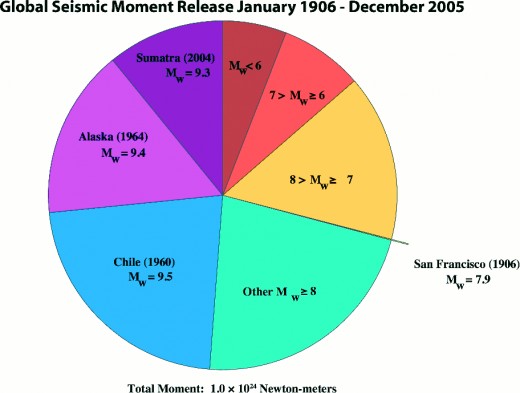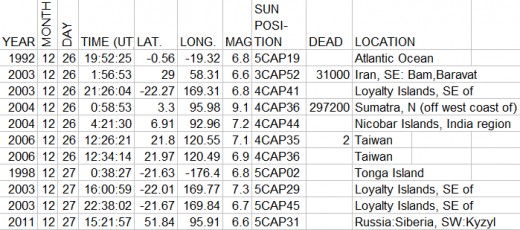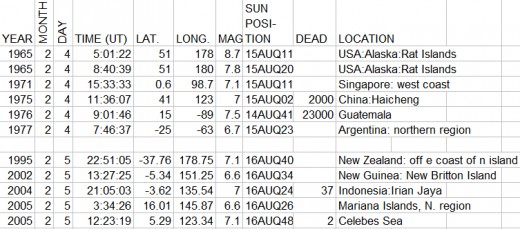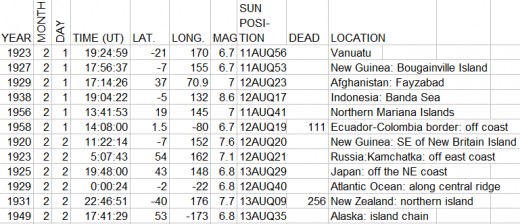Can Sun-Sign Astrology Be Used to Predict Damaging Earthquakes?

Yes It Can!
A few months ago while doing research for an astrology article that I hope to have published in the Mountain Astrologer (it actually ended up in the ISAR International Astrologer published in August 2012), I discovered what looked like a significant sun sign effect that seemed to parallel earthquake activity. From a pool of around 250 earthquake charts that caused at least 800 deaths for each, I found that the percentage of charts with the sun anywhere from 0d45m to 4d45m of Capricorn were several times more numerous than the statistical average for a four degree section of the zodiac.
A few months later, after publishing about 20 hubs, I discovered a Sydney, Australia hub author named claudiafox who had published a piece related to the very same phenomena. From that point I decided that more research should be done related to that anomaly.
Initially using earthquakes in the 6.7 and above magnitude range for the 20 year period of 1992.0 to 2012.0, I found that the effective range was narrower and its center had progressed a degree or two forward. It was my impression that, unlike the siderial motion of the stars relative to our seasons that moves backward in time by a rate of 50 seconds of arc a year, the center of the range had moved forward at the rate of 72 seconds of arc each year (give or take 24 seconds). I wanted to come up with a theory as to why there was such a solar effect to earthquakes and what would cause it to move forward in time, but can't supply you with one.
As an example of how things have progressed: One of my earliest hubs attempted to predict an earthquake off the coast of southeastern Japan around the same time of the year as the double earthquakes of 8+ magnitude that happened there on December 23 & 24, 1854. The hub related the solar effect on earthquakes (also noting a similar relationship that was evident during the Sumatra quake of 2004) and determined that there was a likely earthquake coming in the area within a window that was a bit larger than the dates from December 24 and through the 27th. The expected earthquake happened on January 1st, just 4 days after my window closed. There was also a 6.6 magnitude earthquake in Siberia within the window, but the size of that quake was just under the predicted range estimated. As can be seen from the data below that gives the sun's position for each of the quakes that fall within range of this solar effect, the center of any proposed range should be at least a day further into the future (12/27.0, rather than 12/26.0) than earlier proposed. The expected percentage of events in the 1deg53min window (3CAP52-5CAP45) out of the 360 degree zodiac is 0.5% and the actual occurrence was 1.4% or 2.7Xs greater. Interestingly, at the time of the 9.2 magnitude Sumatra quake of 12/26/2004, my estimate of the center of the window was with the sun at 4CAP41. The sun at the time was located at 4CAP36 or just 5 minutes or 1/12th of a degree before that point at the time of the quake. A good depiction of how much energy was released from that quake can be seen in the pie chart at the top of this article.

When I had first looked at this solar relationship to earthquake events using older data and hand picking quakes that had at least 800 deaths, which represented a much smaller proportion of all the quakes in the 6.7 magnitude or larger range, the effect was more pronounced than when looking at the more recent 20 years of data. That was surprising to me since the effective range was twice as large (due to a pool of data going further back in time and the progression of the center of the degree range over time) and yet it was more rather than a more likely less significant. Was the more distinctive data more relevant at producing compelling results? I don't know the answer to this but it would seem that the more selective data produced a more pronounced effect. The fact that both sets of data produced significant results would seem to indicate that this is not just a statistical aberration.
In reviewing earthquakes in relation to this astrological link, I found a noticeable increase in earthquakes during the approximate time of year as the Chilean earthquake of May 22nd in 1960 (5/21-5/25). After comparing earthquakes from the more recent 20 year period in a roughly three day range of May 25-27, I also found significant results (but not quite as much as with the December 26-27 period). For this range of days, a degree progression of the center of the effective window also moved forward in time, but at a faster rate of 126 seconds or 2.1 minutes of arc per year (give or take 42 seconds or 0.7 minutes). Below are the earthquakes that occurred during that period of time. The expected percentage of events in the 2deg31min window (3GEM48-6GEM19) is 0.7% and the actual occurrence was 1.3% or 1.84Xs greater.

In performing this study I found, due to a more complete record of events from 1992 to the present that a more accurate average for 6.7 magnitude and greater quakes per year is 30.45 rather than 27.77 as I had estimated earlier. I also discovered that, due to magnitude estimates not being perfect, it made sense for me to include 6.6 magnitude earthquakes in my study. This brings the average number of the largest, most likely damaging earthquakes to 39 per year (or one ever 9-10 days on average).
Besides the last two mentioned astrological parallels to earthquakes related to the suns position in the zodiac, there is one last one that demonstrated itself as recently as February 6 of this year. Two earthquakes of 6.7 magnitude occurred within 2.5 hours of each other on this date. The first one was in the Philippines and caused at least 51 deaths. The second was in a remote area of southern Russia near the Mongolian border. The sun at the time of these quakes was at 16d45m and 16d51m of Aquarius (respectively) and less than half of a degree from my estimate of 17d10m Aquarius for the center of a narrow range for the sun's position that seems to coincide with 6.7 magnitude or greater earthquakes (and considerably more often than the statistical average). Like the other two sections of the zodiac, this one also advances each year. It does so faster than the others, progressing approximately 3.3 minutes each year (give or take 1.1 minutes). Below is a list of the earthquakes and dates that relate to this influential section of the zodiac when the sun is located there.

To prove to myself that this wasn't a statistical fluke, I went back in time to a 38 year period that centered on the year 1939 and focused on the dates of February 1st and 2nd. Although the effect then wasn't as substantial as it was for the more recent periods (possibly due to a more incomplete record of earthquakes then), it still produced significant results and confirmed to my satisfaction that this was another example of an astrological sun sign indicator that earthquakes were likely.
In closing, it would seem plausible that the simple notion that the sun, when occupying select sections of particular signs of the zodiac, can act as a signpost for damaging earthquake activity. If the past has any say in the matter, then people should be more earthquake conscious during at least three periods of time in the future: February 5-6, May 26-27, and December 26-27.
Click the following link to go to the first part of my answer to the question 'Can Astrology Charts Forecast Earthquake Risk?'

© 2012 Joseph Ritrovato






